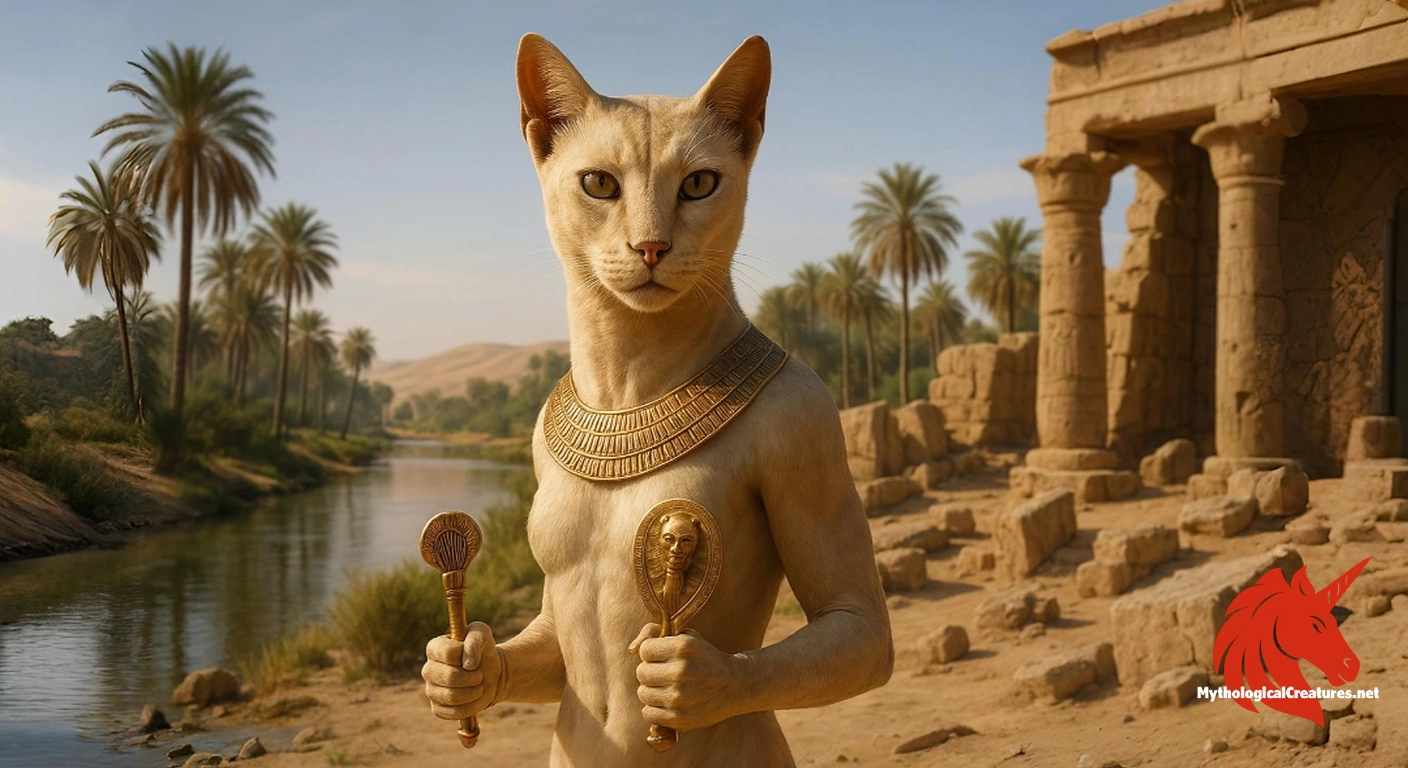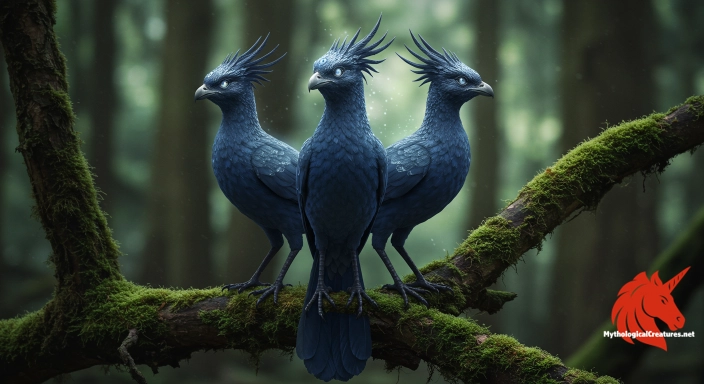Bastet: Bastet is an ancient Egyptian goddess originally worshipped as a lioness, later revered as a gentle domestic cat.

Bastet
Bastet - Bastet was a major protective deity in ancient Egypt, embodying both fierce and nurturing aspects that safeguarded households and ensured fertility.
Origins & First Encounters
Bastet’s origins in the ancient Egyptian pantheon evoke a blend of mystery and transformation. Emerging as a deity possibly rooted in Nubian tradition, she was originally celebrated as a fierce lioness figure who safeguarded both the realms of the living and the divine. Her first attestation reaches back to the Second Dynasty, around 2890 BC, marking an early testament to her venerated status in Lower Egypt. Initially embodying the untamed essence of the lioness, she gradually evolved into the familiar cat goddess, reflecting shifts in societal values and religious practices. This transformation vividly illustrates the dynamic interplay between power and benevolence inherent in her character. Bastet came to symbolise themes ranging from fertility and domesticity to music and revelry, resonating profoundly with both commoners and the elite. The fluidity of her imagery allowed her to serve as a bridge between the martial spirit of ancient warriors and the nurturing energy of home life. Her iconography, steeped in both terror and tenderness, has captivated generations and influenced a wide spectrum of cultural practices. Ultimately, Bastet’s enduring allure and multifaceted nature continue to inspire reverence and artistic expression.
Source Texts & Tale Variants
Ancient inscriptions and temple reliefs offer a fragmented yet evocative glimpse into Bastet’s mythological legacy. Artifacts from Bubastis, her principal cult centre, reveal layers of symbolic meaning embedded in her dualised form as both lioness and goddess of the home. Remnants of ritual texts, discovered in tombs and sacred sites, subtly narrate her role in ancient religious practices. Her cult was further enriched by local festival accounts and ceremonial celebrations that preserved her enduring image. Variations in her portrayal are evident in the scant narratives from Pyramid and Coffin Texts, which hint at both protective and benevolent qualities. As these texts converged with oral traditions, multiple story variants emerged that reimagined her character for different audiences. Greek interpretations, where she was known as Ailuros, provided an alternate perspective that emphasised her feline grace. Additionally, fragments of later genealogies and syncretic records illustrate how Bastet’s myth was continuously adapted to fit evolving cultural contexts. The diversity of sources, despite their fragmentary nature, underscores the depth and complexity of her mythos. Over time, the interplay between written records and lasting oral traditions has allowed her legend to persist across millennia.
Form & Powers
Bastet is frequently portrayed as an elegant figure whose physical depiction evolved alongside her character. In early artistic renditions, she appeared as a formidable lioness, complete with a powerful mane and an imposing posture that exuded raw strength. Over time, her image softened into that of a graceful woman with the refined features of a domestic cat, emphasising subtlety and charm. Her feline head is often adorned with striking, pointed ears and eyes that shimmer with both mystery and alertness. Iconography typically highlights her regal bearing through ornate collars, headdresses, and symbols that reinforce her divine status. Elements of both strength and serenity are interwoven in the details of her depiction, reflecting her dual role as a warrior and nurturer. Intricate carvings and vivid wall paintings suggest that in some periods she retained hints of her lioness origins, serving as a reminder of her initial, more aggressive aspect. The consistent aesthetic across differing periods underscores a careful calibration between ferocity and grace, making her one of the most visually compelling deities of ancient Egypt. Her detailed representations continue to intrigue modern scholars and art enthusiasts alike, offering a window into the evolving artistry of the ancient world.
Regional Faces
The worship of Bastet was deeply embedded in the local culture of Lower Egypt, particularly in the vibrant city of Bubastis, where her temple was a focal point of religious life. Regional practices engraved her dual persona into the fabric of everyday worship, blending martial vigour with a maternal spirit. In the Egyptian Delta, festivals and local ceremonies celebrated her as both a fierce guardian and a gentle protector of the household. Nubian influences contributed layers of complexity to her myth, merging indigenous traditions with the established Egyptian pantheon. As her worship spread beyond Egypt, the Greeks reinterpreted her essence as Ailuros, adapting her imagery to suit Mediterranean sensibilities while retaining her core attributes. This cross-cultural diffusion resulted in subtle regional variations, where local iconography sometimes depicted her with hybrid features that combined Egyptian and neighbouring artistic traditions. The regional adaptations not only reinforced her role as a deity of protection but also ensured her relevance across diverse social and cultural landscapes. Local narratives, enriched by oral traditions and annual rites, further shaped her divine persona in ways that were distinct from the centralised state cult. Through these regional lenses, Bastet emerged as a dynamic deity whose adaptability highlighted the rich tapestry of ancient religious practice.
Cultural Parallels
In comparative mythological studies, Bastet stands out for her unique combination of ferocity and warmth, a duality that resonates with figures from other ancient cultures. Her early identification as a lioness parallels the formidable characteristics of deities like Sekhmet, with whom she shares a familial and functional bond. While Sekhmet embodies a more destructive warrior energy, Bastet represents a lighter, more nurturing aspect, a balance that is mirrored in other dualistic divine figures. The Greek conceptualisation of her as Ailuros echoes a broader Mediterranean fascination with feline symbolism and grace, often linked to divinity and mystery. Similar to goddesses in other traditions who blend martial prowess with everyday guardianship, Bastet’s narrative reflects an enduring archetype of protection and fertility. Her attributes find echoes in the mythic traditions of diverse societies, where the domestic cat is revered for its enigmatic qualities and ability to bridge the wild and the tamed. Such comparisons underscore a universal recognition of the cat as a symbol of both independence and enchantment. The interplay between her fierce origins and her later, more gentle representations invites parallels with other deities whose stories have evolved to mirror societal transformations. This synthesis of traits has cemented her status not only within the Egyptian pantheon but also within a broader context of cross-cultural divine symbolism. Through these multifaceted comparisons, Bastet’s myth encourages a deeper exploration of the interconnected nature of ancient spiritual traditions.
Legacy & Modern Evolution
The legacy of Bastet extends well beyond the corridors of ancient temples, continuing to inspire both spiritual and artistic endeavours in contemporary culture. Over the centuries, her depiction has undergone a profound evolution, shifting from the raw, untamed power of a lioness to the refined elegance of a feline guardian. Modern reinterpretations often frame her as a symbol of female empowerment and the harmonious balance between strength and compassion. Artistic renditions in jewellery, sculpture, and digital media capture her timeless allure, while her image is frequently invoked as an emblem of mystery and domestic comfort. The transformation of her iconography over millennia reflects both the changing tastes of successive cultures and the persistent fascination with the qualities she embodies. In recent years, Bastet has found a renewed resonance among enthusiasts of ancient myth and neopagan traditions, serving as a bridge between antiquity and modern spiritual expression. Her enduring image is celebrated in festivals, cultural re-enactments, and even in popular films that draw on her enigmatic character. Contemporary art often reimagines her as both a fierce protector and a muse for creative expression, highlighting the diverse narratives that her myth inspires. The adaptability of Bastet’s symbolism ensures that she remains a vibrant part of cultural memory, bridging the ancient and the modern with enduring grace.
Interesting Fact
An interesting fact about Bastet is that her cult festival in Bubastis was one of the most joyous and extravagant events in ancient Egypt, known for its music, dancing, and celebrations in her honour.
Quick Creature Info
Origin:
Associations:
Our Mythic Legendary Rating:

Also Sometimes Known As:
Habitat:
Supernatural Powers:
Physical Attributes:
Abilities:
Behavior:
Lore:
References
Discover Another Mythical Legend You May Not Have Heard Of?
Uncover the mysteries of ancient folklore and expand your knowledge of legendary beings from cultures around the world.
Dare to Meet the Adar Rhiannon....
Mythical Disclaimer: The images and data on this site are derived from various historical and literary sources, but we have found that many myths often have multiple versions and interpretations across references, sometimes contradictory. As a result, these creature depictions are artistic interpretations—imaginative blends of folklore, legend, and a dash of AI guesswork. Because creature descriptions vary widely, our illustrations and accompanying information represent our best effort to honor mythology while bridging creative gaps. Enjoy these interpretations—just remember, we've done our best to respect the stories and validate available data, but in the realm of mythology, details often shift, imagination leads the way, and nothing is ever set in stone!
Curated by the Mythological Creatures Team (rev. May 2025)
